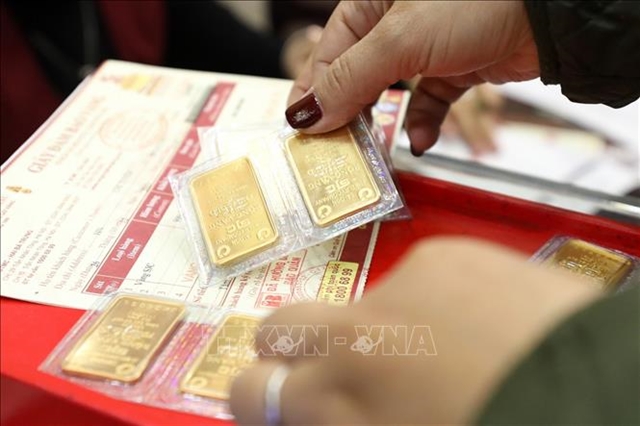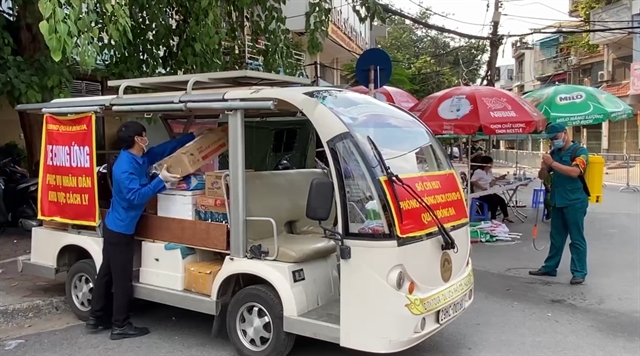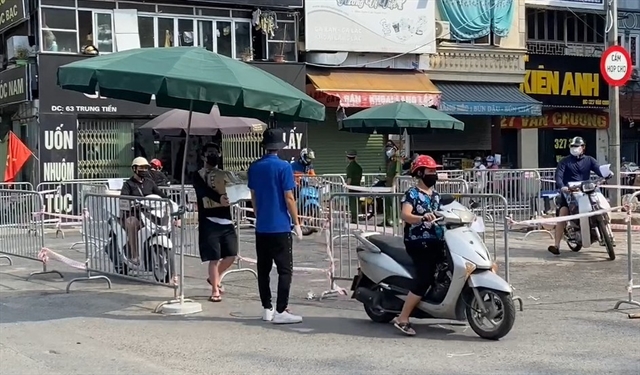 Society
Society

Providing basic necessities for 21,000 people in this area is a huge challenge for local authorities. And it’s also a challenge for delivery drivers, who while providing a valuable service, must do so in a safe way and stick to social distancing regulations.
By Kiều Trinh & Việt Thắng
For more than two weeks, people living in two wards of Văn Chương and Văn Miếu, Đống Đa District, Hà Nội, have been living under lockdown.
Providing basic necessities for 21,000 people in this area is a huge challenge for local authorities.
And it’s also a challenge for delivery drivers, who while providing a valuable service, must do so in a safe way and stick to social distancing regulations.
That’s why part of the area has been sectioned off into an intricate maze-like system so delivery drivers can stay apart from the many others visiting the area.
Nguyễn Thành Hưng, a member of COVID-19 Prevention Headquarters in Đống Đa District, said: “Because of the lockdown situation, all people from 7,100 households of these two wards are not allowed to leave their homes, except for having COVID-19 tests or going to medical facilities for treatment.
“To ensure the needs of local residents, the headquarters has implemented a plan to provide essential goods from outside and inside to the people. We developed a process to receive and transport relief to people in the red areas of two wards, including 3,000 households. Besides, we receive goods from outside and deliver to the families in lockdown three times a week, within a certain time frame to ensure social distancing.
“We have a system to receive goods at four open checkpoints at the edge of lockdown areas and 15 points of distribution of goods inside these two wards. From there, volunteers from COVID community teams, the Youth Union, and Women's Union, take the goods and deliver them to families.”

|
| Necessary items are loaded into the vehicle before sent to delivery points inside the locked down area. VNA/VNS Photo Việt Thắng |
At first glance, the system looks like a complicated maze for all those arriving to negotiate before they can provide supplies for residents inside the lockdown areas.
At the checkpoints, people coming from outside will be instructed to fill out the shipping declaration forms and follow the special passage to keep their distance. Goods will be gathered at transit points and taken to distribution points inside the lockdown area.
Trương Ngọc Anh, a driver from Đồng Xuân Company, said: “We use six vehicles to help deliver goods to people locked down in Văn Chương and Văn Miếu wards. Together with members from the Youth Union, we receive goods and load them into the vehicle.
“After the goods are disinfected, I will drive them into the blocked area and unload them at the distribution point. Representatives of residential groups will take them and deliver to families.”

|
| The "maze" for shippers to keep their distance. VNA/VNS Photo Kiều Trinh |
The system may be a little complicated to begin with, but the drivers quickly understood how to use it.
Lê Thúy Hằng, a resident from Hai Bà Trưng District, brings supplies for her niece living inside the red area.
She said: “I’ve been here twice to send my niece a lot of food and fruits. At first, I felt surprised and confused when using the system, but the police and volunteers here are very helpful. I feel very secure about my family members who are in lockdown.”
The second form of supplying necessities comes from the service of four convenience stores that continue to operate inside the area.
Regional Manager of VinMart+ system Lê Khắc Bình said: “In response to the city's pandemic prevention and control requirements, four of our convenience stories have been operated in lockdown area in Đống Đa District to help provide essential goods for the people in lockdown and to reduce the pressure on local authorities in supplying goods. Each store is capable of handling hundreds of orders per day. All orders are processed online through our website and several Zalo groups. Our staff will prepare each order and deliver them to people.”
Starting a working day at 5:30am and ending at around 10pm, the employees of these stores, who are performing “three on-site services”, are working hard to serve residents.
Being away from family for weeks, their job is even more difficult because the needs of people are very high and diverse, plus they have to take on the additional task of directly delivering goods to each household.
“All the staff in these areas received at least one dose of the vaccine,” Bình added.
“They have to ensure to keep a distance and use non-cash payment. This is an important ‘shield’ to ensure the health and safety of employees, customers and the community.
“We have all clearly defined our roles and responsibilities during the current stressful period, trying to overcome difficulties to ensure adequate service for people.” VNS




